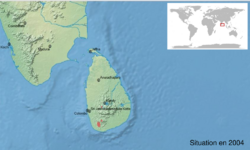Biology:Duttaphrynus noellerti
| Duttaphrynus noellerti | |
|---|---|
| Scientific classification | |
| Domain: | Eukaryota |
| Kingdom: | Animalia |
| Phylum: | Chordata |
| Class: | Amphibia |
| Order: | Anura |
| Family: | Bufonidae |
| Genus: | Duttaphrynus |
| Species: | D. noellerti
|
| Binomial name | |
| Duttaphrynus noellerti (Manamendra-Arachchi and Pethiyagoda, 1998)
| |

| |
| Synonyms | |
|
Bufo noellerti Manamendra-Arachchi and Pethiyagoda, 1998[2] | |
Duttaphrynus noellerti (common name: Noellert's toad) is a species of toads in the family Bufonidae. It is endemic to the rainforests of southwestern Sri Lanka.[3] It is named after Andreas Nöllert, a German herpetologist and photographer who first noted the distinctiveness of the species.[2][4]
Description
Mature males measure 50–62 mm (2.0–2.4 in) and females 80–89 mm (3.1–3.5 in) in snout–vent length. The head has many ridges (the supratympanic ridge being wider than the others) and is covered above and on the sides with smooth warts with melanic spinules; also, the parotoid glands have such warts. The body and the limbs are covered by spinous warts. The dorsum and sides are reddish-ash or reddish-brown, marbled with dark brown. A well-defined dark patch runs from behind the tympanic region and continues onto the flanks and upper surfaces of limbs.[2]
Habitat and conservation
D. noellerti is an uncommon terrestrial toad found in and around tropical lowland moist forest[1] at elevations of 61–460 m (200–1,509 ft) above sea level.[1][5] Adults have been recorded from rubber plantations, tea estates, and domestic gardens, but only close to the forest edge. It is threatened by habitat loss caused by selective logging and agrochemical pollution.[1] It is found in the Kanneliya Forest Reserve,[1][5] Gilimale-Eratne Forest Reserve, and Sinharaja Forest Reserve.[1]
References
- ↑ 1.0 1.1 1.2 1.3 1.4 1.5 IUCN SSC Amphibian Specialist Group (2020). "Duttaphrynus noellerti". IUCN Red List of Threatened Species 2020: e.T54716A156578206. doi:10.2305/IUCN.UK.2020-3.RLTS.T54716A156578206.en. https://www.iucnredlist.org/species/54716/156578206. Retrieved 17 November 2021.
- ↑ 2.0 2.1 2.2 Manamendra-Arachchi, Kelum; Pethiyagoda, Rohan (1998). "A synopsis of the Sri Lankan Bufonidae (Amphibia: Anura), with description of new species". Journal of South Asian Natural History 3: 213–248. http://www.wht.lk/zeylanica/volume-3-number-2/Manamendra-Arachchi%20K.%20%20R.%20Pethiyagoda.%20A%20synopsis%20of%20the%20Sri%20Lankan%20Bufonidae%20Amphibia%20-%20Anura%20with%20description%20of%20new%20species.pdf. Retrieved 2016-04-20.
- ↑ Frost, Darrel R. (2016). "Duttaphrynus noellerti (Manamendra-Arachchi and Pethiyagoda, 1998)". Amphibian Species of the World: an Online Reference. Version 6.0. American Museum of Natural History. http://research.amnh.org/vz/herpetology/amphibia/Amphibia/Anura/Bufonidae/Duttaphrynus/Duttaphrynus-noellerti.
- ↑ Beolens, Bo; Watkins, Michael; Grayson, Michael (2013). The Eponym Dictionary of Amphibians. Pelagic Publishing. p. 156. ISBN 978-1-907807-42-8. https://books.google.com/books?id=QJY3BAAAQBAJ&pg=PA156.
- ↑ 5.0 5.1 Bopage, M. M.; Wewelwala, K.; Krvavac, M.; Jovanovic, O.; Safarek, G.; Pushpamal, V. (2011). "Species diversity and threat status of amphibians in the Kanneliya Forest, lowland Sri Lanka". Salamandra 47 (3): 173–177. http://www.salamandra-journal.com/index.php/home/contents/2011-vol-47/255-bopage-m-m-k-wewalwala-m-krvavac-o-jovanovic-g-safarek-v-pushpamal/file.
Wikidata ☰ Q587538 entry
 |


